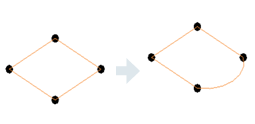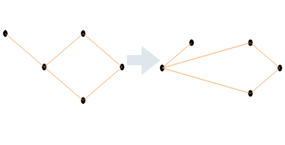Ознакомьтесь с новыми интерфейсом API в контексте аналитического моделирования.
- Используйте аналитическое моделирование для представления индивидуальных проектных решений в отношении элементов конструкций и зданий/конструкций, которые рассматриваются как единое целое.
- Создавайте аналитические представления для конструкций любого типа.
- Создавайте согласованные аналитические модели, позволяющие выполнять расчет конструкций на основе моделей Revit.
- Выполняйте полнофункциональный двунаправленный рабочий процесс с помощью программного обеспечения для расчетов и фиксации внесенных в модель изменений.
- При необходимости предотвращайте внесение непредвиденных изменений в аналитическую модель.
- Создавайте несколько аналитических моделей, отражающих различные типы и конфигурации расчетов.
- Простота аналитического моделирования, аналогичного возможностям специализированного программного обеспечения для расчета конструкций, сочетается с мощными возможностями параметрического моделирования и совместной работы на платформе BIM.
Элементы Revit с новым API
Новые классы API
AnalyticalElement — элемент, представляющий базовый класс для всех аналитических объектов. Он заменил собой элемент AnaltyicalModel.
-
Transform GetTransform () - Returns the transform which reflects Analytical Element orientation.
-
AnalyzeAs AnalyzeAs - This represents the Analyze As parameter assigned to Analytical Element.
-
Reference GetReference (AnalyticalModelSelector selector) - Returns a reference to a given curve within the Analytical Element.
-
ElementId MaterialId - Defines the Material Id for the Analytical Element.
AnalyticalMember — элемент, представляющий линейный элемент в аналитической модели несущей конструкции. Он заменил собой элементы AnalyticalModelStick и AnalyticalModelColumn.
-
AnalyticalMember Create(Document aDoc,Curve curve) - Method which creates a new instance of an Analytical Member within the project.
-
AnalyticalStructuralRole StructuralRole - The structural role assigned to the Analytical Member.
-
Curve GetCurve () - Returns the curve of the Analytical Member.
-
void SetCurve(Curve curve) - Sets the curve for the Analytical Member. This method disconnects elements from other analytical elements (if the end nodes are in the same position).

If the user wants to move the corner, and keep the connection, there are other ways for achieving that such as ElementTransformUtils.moveElements.
-
bool IsValidCurve(Curve curve) - Verifies if the curve is valid for an Analytical Member.
-
void FlipCurve() - Flips the ends of the Analytical Member.
-
StructuralSectionShape StructuralSectionShape - The structural section shape of the Analytical Member (read only).
-
ElementId SectionType - The id of the type from the structural family assigned to the Analytical Member.
-
double CrossSectionRotation - Cross-section rotation of the Analytical Member.
-
AnalyticalPanel Create(Document aDoc, CurveLoop curveLoop) - Method which creates a new instance of an Analytical Panel within the project.
-
CurveLoop GetOuterContour() - Returns the Curve Loop that defines the geometry of the Analytical Surface element.
-
bool IsCurveLoopValid(CurveLoop profile) - Checks if curve loop is valid for Analytical Panel.
- Для изменения геометрии аналитической панели следует использовать структуру SketchEditScope. В эту структуру добавлен новый метод:
-
void StartWithNewSketch(ElementId elementId) - Starts a sketch edit mode for an element which, at this moment, doesn't have a sketch.
-
- Другой способ редактирования геометрии:
-
void SetOuterContour(CurveLoop outerContour) - Sets the Curve Loop that defines the geometry of the Analytical Surface element.

-
Как и для AnalyticalMember, задание контура для аналитической панели приведет к разрыву соединения с другими аналитическими элементами. Существуют другие способы переместить угол и сохранить соединение, например ElementTransformUtils.moveElements.
-
- Для изменения геометрии аналитической панели следует использовать структуру SketchEditScope. В эту структуру добавлен новый метод:
-
ISet<ElementId> GetAnalyticalOpeningsIds() - Returns the Analytical Openings Ids of the Analytical Panel.
-
ElementId SketchId - Sketch associated to this Revit element.
-
AnalyticalStructuralRole StructuralRole - Structural role assigned to the Analytical Panel.
-
AnalyticalOpening Create(Document doc, CurveLoop curveLoop, ElementId panelId) - Method which creates a new instance of an Analytical Opening within the project.
-
CurveLoop GetOuterContour () - Returns the Curve Loop that defines the geometry of the Analytical Surface element.
-
bool IsCurveLoopValidForAnalyticalOpening(CurveLoop loop, Document aDoc, ElementId panelId) - Checks if curve loop is valid for Analytical Opening.
- Для изменения геометрии аналитического проема используется структура SketchEditScope.
- Еще один способ изменения геометрии аналитического проема:
-
void SetOuterContour(CurveLoop outerContour) - Sets the Curve Loop that defines the geometry of the Analytical Surface element.
-
-
ElementId PanelId - ElementId of the host Analytical Panel.
-
ElementId SketchId - Sketch associated to this Revit element.
AnalyticalToPhysicalAssociationManager — элемент, управляющий ассоциациями между аналитическими и физическими элементами. Раньше элементы сами получали сведения друг о друге, а у пользователя не было возможности управлять ими (ассоциацию нельзя было изменить). Новый подход позволяет редактировать ассоциацию. Поддерживается ассоциация «один к одному», при этом каждый элемент не могут быть частью нескольких связей одновременно.
-
AnalyticalToPhysicalAssociationManager GetAnalyticalToPhysicalAssociationManager(Document doc) Returns the AnalyticalToPhysicalAssociationManager for this document.
-
void AddAssociation(ElementId analyticalElementId, ElementId physicalElementId) - Adds a new association between an analytical element and a physical element.
-
void RemoveAssociation(ElementId elementId) - This method will remove the association for the element with the given ElementId.
-
ElementId GetAssociatedElementId (ElementId elementId) - Returns id of the element which is associated with the given ElementId.
-
bool HasAssociation(ElementId id) - Verifies if the element has already defined an association.
-
AnalyticalNodeData GetAnalyticalNodeData ( Element element) - Returns AnalyticalNodeData associated with this element, if it exists.
-
AnalyticalNodeConnectionStatus GetConnectionStatus () - Returns the Connections Status for an Analytical Node.
Для работы с новыми элементами были перенесены классы AnalyticalLinks, BoundaryConditions и Loads. В большинстве случаев интерфейс API, связанный с ними, остается неизменным. Некоторые усовершенствования были внесены в класс Loads.
-
LineLoad.Create(Document aDoc,ElementId hostElemId, XYZ forceVector1, XYZmomentVector1, LineLoadType symbol).
-
LineLoad.Create(Document aDoc,ElementId hostElemId, int curveIndex, XYZ forceVector1, XYZ momentVector1, Structure.LineLoadType symbol).
-
LineLoad.IsValidHostId(Document doc, ElementId hostElemId).
-
AreaLoad.IsValidHostId(Document doc, ElementId hostElemId).
-
AreaLoad.Create(Document doc, ElementId hostElemId, XYZ forceVector1, AreaLoadType symbol).
-
PointLoad.Create(Document doc, ElementId hostElemId, AnalyticalElementSelector selector, XYZ forceVector, XYZ momentVector, AreaLoadTyp symbol).
-
PointLoad.IsValidHostId(Document doc, ElementId hostElemId).
Образцы
Создание аналитического элемента
using (Transaction transaction = new Transaction(document, "Create Analytical Member"))
{
transaction.Start();
//create curve which will be assigned to the analytical member
Line line = Line.CreateBound(new XYZ(0, 0, 0), new XYZ(5, 0, 0));
//create the AnalyticalMember
AnalyticalMember analyticalMember = AnalyticalMember.Create(document, line);
analyticalMember.StructuralRole = AnalyticalStructuralRole.StructuralRoleBeam;
transaction.Commit();
}
Создание аналитической панели
using (Transaction transaction = new Transaction(revitDoc, "Create Analytical Panel"))
{
transaction.Start();
//create the curveLoop for the AnalyticalPanel element
CurveLoop profileloop = new CurveLoop();
profileloop.Append(Line.CreateBound(new XYZ(1, 1, 0), new XYZ(2, 1, 0)));
profileloop.Append(Line.CreateBound(new XYZ(2, 1, 0), new XYZ(2, 2, 0)));
profileloop.Append(Line.CreateBound(new XYZ(2, 2, 0), new XYZ(1, 2, 0)));
profileloop.Append(Line.CreateBound(new XYZ(1, 2, 0), new XYZ(1, 1, 0)));
//create the AnalyticalPanel
analyticalPanel = AnalyticalPanel .Create(revitDoc, profileloop);
transaction.Commit();
}
Добавление новой ассоциации между физическим и аналитическим элементами
using (Transaction trans = new Transaction(doc, "AddAssociationBetweenPhysicalAndAnalyticalElements"))
{
trans.Start();
ElementId analyticalElementId = ContextualAnalyticalModel.Utilities.GetSelectedObject(activeDoc, "Please select analytical element");
ElementId physicalElementId = ContextualAnalyticalModel.Utilities.GetSelectedObject(activeDoc, "Please select physical element");
//gets the AnalyticalToPhysicalAssociationManager for the current document
AnalyticalToPhysicalAssociationManager analyticalToPhysicalManager = AnalyticalToPhysicalAssociationManager.GetAnalyticalToPhysicalAssociationManager(doc);
if (analyticalToPhysicalManager == null)
return Result.Failed;
//creates a new association between physical and analytical elements
analyticalToPhysicalManager.AddAssociation(analyticalElementId, physicalElementId);
trans.Commit();
}
Редактирование границы аналитической панели с помощью структуры SketchEditScope

// Start a sketch edit scope
SketchEditScope sketchEditScope = new SketchEditScope(document, "Replace line with an arc");
sketchEditScope.StartWithNewSketch(analyticalPanel.Id);
using (Transaction transaction = new Transaction(document, "Modify sketch"))
{
transaction.Start();
//replace a boundary line with an arc
Line line = null;
Sketch sketch = document.GetElement(analyticalPanel.SketchId) as Sketch;
if (sketch != null)
{
//find first line in the sketch profile
…..
}
// Create arc
XYZ normal = line.Direction.CrossProduct(XYZ.BasisZ).Normalize().Negate();
XYZ middle = line.GetEndPoint(0).Add(line.Direction.Multiply(line.Length / 2));
Curve arc = Arc.Create(line.GetEndPoint(0), line.GetEndPoint(1), middle.Add(normal.Multiply(20)));
// Remove element referenced by the found line.
document.Delete(line.Reference.ElementId);
// Model curve creation automatically puts the curve into the sketch, if sketch edit scope is running.
document.Create.NewModelCurve(arc, sketch.SketchPlane);
transaction.Commit();
}
sketchEditScope.Commit(new FailurePreproccessor());
Перемещение узла аналитической модели и сохранение соединения

// Create Analytical Panel
AnalyticalPanel analyticalPanel = CreateAnalyticalPanel.CreateAMPanel(document);
// Create the connected Analytical Member
AnalyticalMember analyticalMember = CreateAnalyticalMember.CreateMember(document);
// Select the node
Reference eRef = activeDoc.Selection.PickObject(ObjectType.PointOnElement , "Select an Analytical Node");
// Move the Analytical Node using ElementTransformUtils
using (Transaction transaction = new Transaction(document, "Move node with ElementTransformUtils"))
{
transaction.Start();
ElementTransformUtils.MoveElement(document, eRef.ElementId, new XYZ(-5, -5, 0));
transaction.Commit();
}
Получение точек контура аналитической поверхности
private List<XYZ> GetSurfaceContourPoints( Document doc, ElementId elementId )
{
// Create point list, get list of curves from analytical model
List<XYZ> contourPoints = new List<XYZ>();
AnalyticalModel analyticalModel = (doc.GetElement(elementId) as AnalyticalModel);
IList<Curve> curves = analyticalModel.GetCurves(AnalyticalCurveType.RawCurves);
// Iterate over curves and make the desired processing
…...
return contourPoints;
}
private List<XYZ> GetSurfaceContourPoints( Document doc, ElementId elementId )
{
// Create point list, get list of curves from analytical model
List<XYZ> contourPoints = new List<XYZ>();
AnalyticalPanel analyticalPanel = (doc.GetElement(elementId) as AnalyticalPanel);
CurveLoop outerContour = analyticalPanel.GetOuterContour();
// Iterate over curves and make the desired processing
…...
return contourPoints;
}
Получение связанного аналитического элемента для физического
AnalyticalElement GetAnalyticalElement(Element physicalElement)
{
AnalyticalElement analyticalElement = null;
Document document = element.Document;
AnalyticalToPhysicalAssociationManager assocManager = AnalyticalToPhysicalAssociationManager.GetAnalyticalToPhysicalAssociationManager(document);
if (assocManager != null)
{
ElementId associatedElementId = assocManager.GetAssociatedElementId(physicalElement.Id);
if (associatedElementId != ElementId.InvalidElementId)
{
Element associatedElement = document.GetElement(associatedElementId);
if (associatedElement != null && associatedElement is AnalyticalElement)
{
analyticalElement = associatedElement as AnalyticalElement;
}
}
}
return analyticalElement;
}
Создание граничных условий «Линия»
Предыдущее решение:
private BoundaryConditions CreateLineBC(Element hostElement)
{
Document createDoc = hostElement.Document.Create;
// use Document.NewLineBoundaryConditions Method
BoundaryConditions createdBC =
createDoc.NewLineBoundaryConditions(hostElement.GetAnalyticalModel(), 0, 0, 0, 0, 0, 0, 0, 0);
return createdBC;
}
Новое решение:
private BoundaryConditions CreateLineBC(Element hostElement)
{
Document createDoc = hostElement.Document.Create;
// use Document.NewLineBoundaryConditions Method
AnalyticalElement analyticalElement = GetAnalyticalElement(hostElement);
BoundaryConditions createdBC =
createDoc.NewLineBoundaryConditions(analyticalElement, 0, 0, 0, 0, 0, 0, 0, 0);
return createdBC;
}